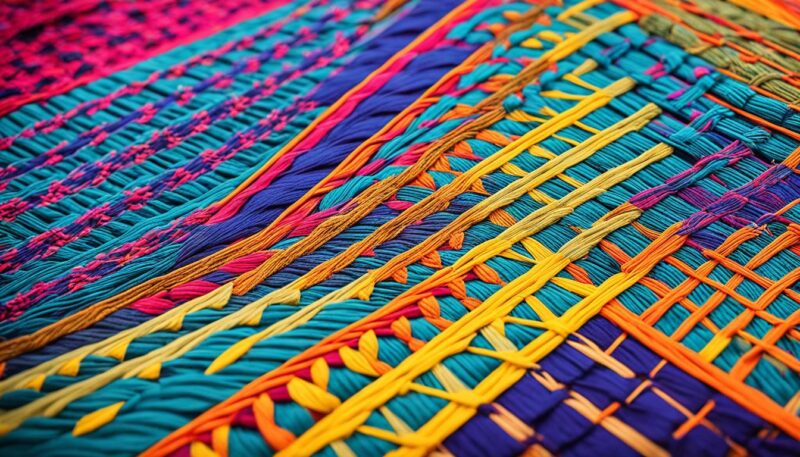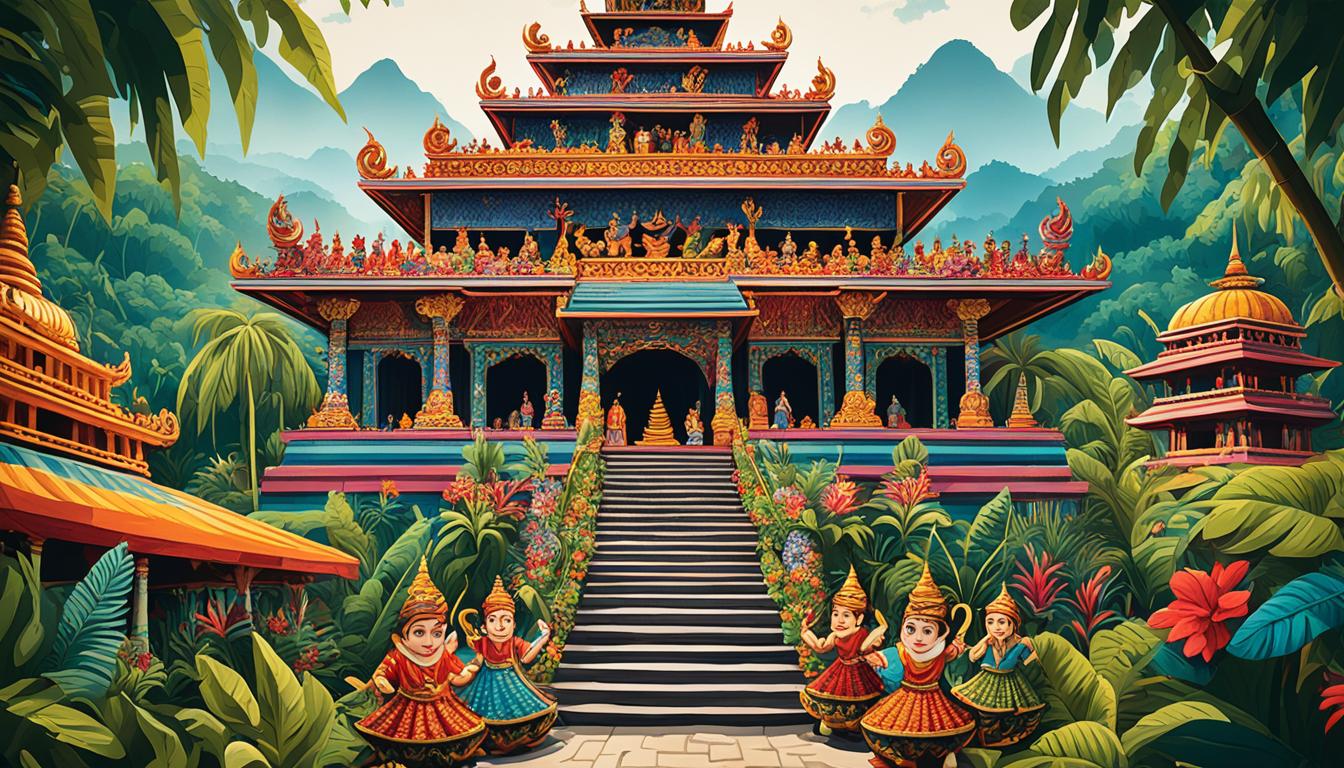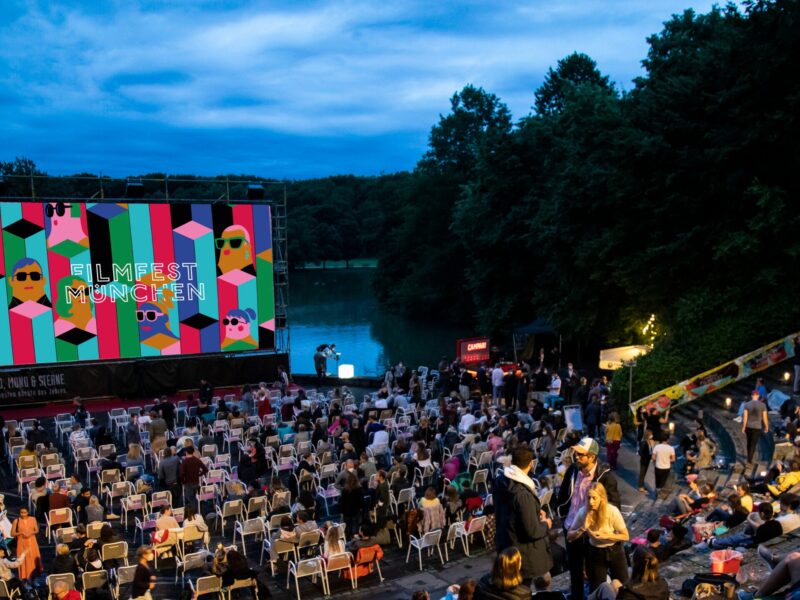Did you know that Malaysia is home to a vibrant cultural heritage that blends various religions and influences from around the world? With a population of over 32 million people, this Southeast Asian country is a melting pot of traditions, celebrations, and architectural marvels that tell captivating stories about its history.
Imagine immersing yourself in the sights, sounds, and flavors of Malaysia, surrounded by the vibrant colors of festivals, the intricate designs of traditional crafts, and the enchanting rhythms of music and dance. With custom tours, you can create a personalized itinerary to explore the cultural gems of this diverse nation, discovering the richness of its heritage and creating unforgettable memories.
Key Takeaways:
- Malaysia’s rich heritage reflects its diverse population and blends various religions and cultural influences.
- Custom tours allow visitors to immerse themselves in the vibrant festivals, diverse architecture, traditional handicrafts, and captivating music and dance traditions of Malaysia.
- Understanding the cultural etiquette of Malaysia is important when visiting to ensure a respectful and enriching experience.
- Tailor-made tours in Malaysia offer the opportunity to explore bustling cities, historical sites, and the natural beauty of the rainforests.
- Experience the unique culture and heritage of Malaysia through customized tours that cater to your interests and preferences.
Witness the Cultural Festivals of Malaysia
Malaysia is renowned for its vibrant cultural festivals that offer visitors a window into the country’s rich traditions and cultural heritage. Throughout the year, Malaysia celebrates a diverse array of religious and cultural celebrations, providing tourists with the opportunity to witness the colorful and lively festivities.
Visitors can partake in and experience a variety of festivals throughout Malaysia, including the major religious celebrations of Eid, Chinese New Year, Diwali, and Christmas. These festivals showcase the multicultural nature of Malaysia and highlight the harmonious coexistence of different religions within the country.
In addition to the major festivals, Malaysia also celebrates a range of Malay festivals, allowing visitors to immerse themselves in the unique customs and traditions of the local people. Festivals such as Hari Raya Aidilfitri, Awal Muharram, Sabah Kaamatan, and Sarawak Gawai offer a chance to experience traditional Malay cultural practices and enjoy the vibrant festivities.
For those seeking a more intimate and off-the-beaten-path cultural experience, smaller religious festivals like the Hindu Thaipusam festival provide the opportunity to witness unique rituals and processions. These festivals often feature traditional performances, music, and dance, further enriching the cultural experience.
By participating in the cultural festivals of Malaysia, visitors can gain a deeper understanding of the country’s diverse heritage and experience the warmth and hospitality of the Malaysian people.
Quotes:
“The cultural festivals of Malaysia offer a truly immersive experience, allowing visitors to witness the rich tapestry of traditions and customs that define the country’s cultural identity.” – Travel enthusiast
Major Festivals in Malaysia
| Festival | Date | Location |
|---|---|---|
| Eid | Varies (based on the Islamic calendar) | Throughout Malaysia |
| Chinese New Year | Varies (based on the lunar calendar) | Throughout Malaysia |
| Diwali | Varies (based on the Hindu calendar) | Throughout Malaysia |
| Christmas | December 25th | Throughout Malaysia |
| Hari Raya Aidilfitri | Varies (based on the Islamic calendar) | Throughout Malaysia |
| Awal Muharram | Varies (based on the Islamic calendar) | Throughout Malaysia |
| Sabah Kaamatan Festival | May 30th – May 31st | Sabah |
| Sarawak Gawai Festival | June 1st – June 2nd | Sarawak |
Explore Malaysia’s Diverse Architecture
Malaysia’s architecture is a testament to its rich history and diverse influences. The country’s colonial past has deeply influenced its architectural style, resulting in a fascinating blend of different designs and structures.
The British, Dutch, and Portuguese colonial influences are particularly prominent in Malaysia’s architectural landscape. One iconic example is the Sultan Abdul Samad Building in Kuala Lumpur, a magnificent structure that showcases the grandeur of British colonial architecture. This historic building, with its clock tower and Moorish-style façade, serves as a symbol of Malaysia’s colonial heritage.
Another notable colonial architectural gem can be found in Melaka, where heritage homes reflect the Dutch influence. These well-preserved houses exhibit unique Dutch design elements, such as gables and ornate facades, providing a glimpse into Malaysia’s colonial past.
In addition to European influences, Chinese architecture holds a significant presence in Malaysia’s architectural landscape. Temples and heritage homes in Melaka and Penang display intricate Chinese designs, characterized by elaborate decorations and vibrant colors. These architectural treasures not only add to Malaysia’s cultural diversity but also showcase the enduring influence of Chinese communities in the country.
Islamic architecture is another striking feature of Malaysia’s built environment. From modern skyscrapers to traditional mosques, Islamic design elements can be found throughout the country. The iconic Petronas Twin Towers in Kuala Lumpur, with their Islamic-inspired motifs and soaring heights, represent a harmonious fusion of modernity and tradition.
Malaysia’s indigenous communities, particularly in Sabah and Sarawak, boast traditional Malay architecture. The houses, built on stilts, showcase the ingenuity of these communities in creating structures that are adapted to the local environment. These architectural gems not only reflect Malaysia’s rich cultural diversity but also stand as a testament to the indigenous people’s profound connection to their land.
In summary, Malaysia’s architectural heritage presents a captivating blend of influences from its colonial past and diverse cultural traditions. From colonial-era buildings to traditional Malay houses, the country’s architecture tells a story of resilience, creativity, and cultural exchange.
Experience Malaysia’s Handicrafts and Artistic Traditions
Malaysia’s rich cultural heritage is not only reflected in its festivals and architecture but also in its vibrant handicrafts and artistic traditions. Influenced by Islamic traditions and the natural beauty of the country, Malaysia’s artisans create exquisite pieces that showcase their skills and creativity. Whether you’re a seasoned collector or simply appreciate the beauty of handmade crafts, exploring Malaysia’s diverse handicrafts scene is a must-do for any visitor.
One of the best ways to immerse yourself in Malaysia’s handicrafts is by visiting the numerous craft markets and shops scattered across the country. Here, you can discover a stunning array of items, including pottery, wooden crafts, bronze and brass work, and traditional silver jewelry. The intricate designs and attention to detail are a testament to the artistic talents of Malaysian artisans.
A notable community known for their artistic ability is the Orang Ulu people. They create breathtaking wood carvings, intricate murals, and beautiful beadwork, showcasing their deep connection to nature and their rich cultural heritage. These unique pieces are often inspired by traditional motifs and patterns that have been passed down through generations.
In addition to woodwork and metal crafts, Malaysia is renowned for its handwoven textiles and traditional fabrics. Crafted from local plant fibers, these textiles showcase the country’s long-standing tradition of weaving. Popular examples include batik, a technique of using wax to create intricate patterns on fabric, and songket, a luxurious fabric woven with metallic threads. These traditional textiles are used to create a wide range of products, from designer clothing to home decor items.

Exploring Malaysia’s handicrafts and artistic traditions is not just about admiring the final products—it’s about experiencing the culture and stories behind each piece. Many artisans are happy to share their techniques and stories, giving you a deeper appreciation for their craft. You can even try your hand at creating your own masterpiece by participating in workshops and classes offered by local artisans.
When you bring home a piece of Malaysian handicraft, you’re not just purchasing an item; you’re taking a part of Malaysia’s rich cultural heritage with you. Whether it’s a hand-carved wooden sculpture, a beautiful batik painting, or a stunning piece of jewelry, each piece tells a unique story and preserves the artistic traditions of Malaysia.
So, don’t miss the opportunity to explore Malaysia’s handicrafts and artistic traditions during your visit. Dive into the vibrant world of Malaysian craftsmanship and take home a piece of the country’s rich cultural tapestry.
You can also read: Exploring Zanzibar Safety
Discover Malaysia’s Music and Dance Traditions
Malaysia’s music and dance traditions are an integral part of its cultural heritage. The country’s rich musical landscape encompasses various genres and styles, each representing the diverse cultural tapestry of Malaysia. From traditional orchestras like gamelan and nobat to the mesmerizing beats of the rebana uni drums and kompang, Malaysia’s traditional music offers a captivating experience for visitors.
Among the traditional instruments, the sape flute holds a special place, with its enchanting melodies resonating through the lush rainforests and tribal communities. These music traditions reflect the deep connections Malaysians have with their natural surroundings and their unique cultural backgrounds.
And it’s not just the music that showcases the richness of Malaysian culture. The dance forms of Malaysia are equally captivating. Traditional dances like the Datun Julud, Joget, Kuda Kepang, and Lion dance bring to life the vibrant heritage of the country. These dances are a vibrant display of rhythm, grace, and storytelling, celebrating a range of Malaysian traditions and historical events.
In addition to traditional dances, Malaysia also embraces cultural influences from neighboring countries. Dance forms like Bharatanatyam from India and Bhangra from Malaysia’s Sikh community add a colorful fusion to the country’s dance traditions.
Not to be missed are the cultural performances like Mak Yong, Silat, Sumazau, Tarian Lilin, and Zapin, each with its unique style and significance. These performances provide a deep dive into the diverse cultural fabric of Malaysia, showcasing the talent and creativity of its people.
Whether it’s the rhythmic beats of traditional music or the graceful movements of dance, Malaysian music and dance traditions offer a mesmerizing experience that allows visitors to immerse themselves in the local culture. The fusion of different styles and influences creates a tapestry of sounds and movements that celebrate the diversity and unity of Malaysia’s cultural heritage.
Cultural Etiquette in Malaysia
When visiting Malaysia, it is important to be aware of the cultural etiquette. Understanding the customs and traditions of the country can help ensure a respectful and enjoyable experience. Here are some key points to keep in mind:
Greetings
Malay women typically do not shake hands with men, while Malay Chinese may shake hands lightly and for a prolonged period. It is considered polite to greet the older members of a family first as a sign of respect.
Gift Giving
Gift giving is a common practice in Malaysia, especially when invited to someone’s home. When selecting gifts, chocolates or pastries are a popular choice. However, it is important to avoid giving gifts such as toy dogs or pigs, alcohol, or flowers, as these may be considered inappropriate in certain contexts. When presenting the gift, it is customary to offer it with the right hand or both hands as a sign of respect.
Dress Code
While Western clothing is generally accepted in urban areas, it is advisable to dress more conservatively when visiting rural and traditional areas. In these settings, it is respectful to avoid overly revealing attire and to opt for clothing that covers the shoulders and knees. By adhering to the local dress code, visitors can show their appreciation for the culture and customs of Malaysia.
By being mindful of Malaysian greetings, gift giving customs, and dress code, visitors can navigate the cultural landscape with ease and respect. Embracing these cultural etiquette practices can lead to meaningful connections and a deeper appreciation of Malaysia’s rich heritage.
Conclusion
Malaysia offers a wealth of cultural experiences and heritage sites for visitors to explore. With its vibrant festivals, diverse architecture, traditional handicrafts, and captivating music and dance performances, Malaysia immerses travelers in a rich cultural tapestry. Custom tours in Malaysia allow visitors to tailor their itineraries to match their specific interests and preferences, ensuring a truly personalized travel experience.
From the bustling cities to the historical sites, Malaysia provides an array of opportunities to discover its unique heritage. Explore the grandeur of colonial-era buildings like the Sultan Abdul Samad Building, or wander through the traditional longhouses in the indigenous communities of Sabah and Sarawak. The country’s handicrafts industry offers a treasure trove of traditional pottery, wooden crafts, textiles, and jewelry influenced by Islamic traditions.
Music and dance traditions in Malaysia are a celebration of its diverse culture. Experience the mesmerizing melodies of gamelan and the energetic Joget dance, or witness the captivating performances of Bharatanatyam and Mak Yong. These cultural treasures showcase the depth and richness of Malaysian traditions.
Whether you choose to explore the vibrant cities, delve into historical sites, or venture into the natural beauty of Malaysia’s rainforests, a custom tour in Malaysia promises an unforgettable travel experience. Immerse yourself in the country’s cultural heritage and create memories that will last a lifetime.
FAQ
What cultural experiences can I expect on a custom tour of Malaysia?
On a custom tour of Malaysia, you can expect to explore the country’s rich heritage through various cultural experiences. Witness vibrant festivals, such as Eid, Chinese New Year, and Diwali, and immerse yourself in the unique traditions of Malay festivals like Hari Raya Aidilfitri and Awal Muharram. You can also explore diverse architectural styles influenced by Malaysia’s colonial past and discover traditional handicrafts and artistic traditions.
What are some of the cultural festivals celebrated in Malaysia?
Malaysia celebrates a variety of cultural festivals throughout the year. Some of the festivals you can witness include Eid, Chinese New Year, Diwali, Christmas, Hari Raya Aidilfitri, Awal Muharram, Sabah Kaamatan Festival, Sarawak Gawai Festival, and the Hindu Thaipusam festival. These festivals showcase the cultural diversity and traditions of Malaysia.
What architectural styles can be found in Malaysia?
Malaysia’s architecture is a blend of different styles influenced by its diverse history. You can find colonial architecture with British, Dutch, and Portuguese influences in buildings like the Sultan Abdul Samad Building in Kuala Lumpur and heritage homes in Melaka. Chinese architecture is prominent in temples and heritage homes in Melaka and Penang. Islamic influences can be seen in modern buildings and mosques across the country, while traditional Malay architecture can be found in indigenous communities of Sabah and Sarawak.
What is the handicrafts industry like in Malaysia?
Malaysia has a thriving handicrafts industry influenced by Islamic traditions and nature. Visitors can explore craft markets and shops offering pottery, wooden crafts, bronze and brass work, traditional silver jewelry, tribal headdresses, handwoven crafts, batiks, and songket textiles. The Orang Ulu community is known for its artistic ability in wood carvings, murals, and beadwork. The handicrafts industry offers a wide range of traditional crafts and unique cultural experiences.
What music and dance traditions can be found in Malaysia?
Malaysia boasts a rich heritage of music and dance traditions. Traditional music includes orchestras like gamelan and nobat, as well as drums like the rebana uni and kompang, and the sape flute. Popular music and dance genres include Datun Julud, Joget, Kuda Kepang, Lion dance, Bharatanatyam, Bhangra, Mak Yong, Silat, Sumazau, Tarian Lilin, and Zapin. These performances showcase the diversity and cultural richness of Malaysia.
What cultural etiquette should I be aware of when visiting Malaysia?
When visiting Malaysia, it is important to be mindful of cultural etiquette. Malay women typically do not shake hands with men, while Malay Chinese may shake hands lightly and for a longer duration. It is polite to greet older family members first. When giving gifts, chocolates or pastries are common choices, but it is best to avoid giving toy dogs or pigs, alcohol, or flowers. Gifts should be offered with the right hand or both hands. When visiting rural and traditional areas, it is recommended to dress respectfully and avoid overly revealing attire.
How can I make the most of my cultural experiences in Malaysia?
To make the most of your cultural experiences in Malaysia, consider customizing your tour to match your specific interests and preferences. Whether you’re interested in exploring bustling cities, visiting historical sites, or venturing into the natural beauty of the rainforests, a tailor-made tour can ensure you have an unforgettable travel experience in Malaysia.


